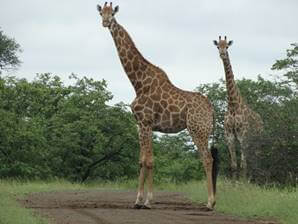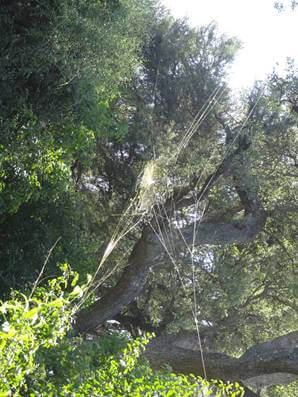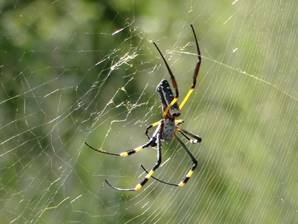GROOTVLEI

The ‘dry’ section of the H1-6
Readers of this blog will already be familiar with Kruger’s main north-south road, the H1 and the H1-6 section which is north of Letaba. As it goes all the way to Shingwedzi, a distance of 134 km involving, at the very least, a three hour drive, it is, as already mentioned elsewhere, definitely the longest part of the H1.
Some 15 km north of Mopani, just before the northern turn-off onto the Shongololo Loop (S142 - see the lower left section of the map), the H1-6 turns away from the Tsendze River and enters very dry territory where we have had very little luck with regard to sightings. This unexciting section stretches to the Red Rocks turn-off (see the upper left corner of the map).
So, rather than travelling to Shingwedzi via the H1-6, we are going to take the S50, also known as the Dipeni Road.

You should be familiar with the southernmost reaches of the S50, for we have been referring to it as the Nshawu Marsh Road. Shortly after passing the Nshawu Dam on our right, we come to what appears to be a fork in the road. To the left is the Capricorn Loop, which would take us through Little Serengeti.
Instead, we bear right to continue on the Dipeni Road.
For the first few kilometres, you are likely to still see game because of the proximity of the marsh. Impala, zebra, giraffe, wildebeest, Waterbuck and elephant are often here. We have also had good sightings of Tsessebe.
Then the road curves to the north-east, away from the Nshawu River and after about 8 kilometres brings us within a kilometre or two of the Lebombo Hills, the border between the Park and Mozambique. Although we have not seen much along here with regard to game, we always continue to look out for Kruger’s birds. The Red-crested Korhaan are often on or near the road.
The road then turns north and for the next 25 km or so, you remain, metaphorically speaking, in the shadow of the Lebombos. The first few kilometers of this stretch remain dry - with regard to water and game! - but the views of the Lebombos makes up for it.

Part of the Lebombo Range.

Close up of the cave-like overhang.
We soon reach the turn-off to the Shibavantse Lookout point on the Lebombos. It is worth the effort to travel up the rough, steep road as it provides a magnificent view of the vast stretches of mopane veld.
Once we have passed the turn-off to the lookout, we again start to see signs of life, such as buffalo, Nyala, giraffe and even Sharpe’s Grysbok (more about this exquisite little buck later).

My favourite photo from this area south of Grootvlei.
The Grootvlei Dam is more or less halfway between Mopani and Shingwedzi and is a good place to stop and have breakfast. (Grootvlei is Afrikaans for Big Marsh. The pronunciation of the letter ‘g’ in Afrikaans is the same as the ‘ch’ in the Scottish ‘och’ or the German ‘ach’. Thus CHROOT-flay with the ‘oo’ as in moor or tour.)
There are two places where you can park to view the dam. The first is as you reach the dam on the eastern side. On our last visit we had a fantastic sighting of a group of young bull elephants from here. When we arrived we began the ascent to the wall, but then saw the elephants leaving the dam, as you can see on the right.


They climbed up onto the wall, and we waited patiently to see which way they were going. Our intention was to drive along the top of the wall to get to the second parking place, on the western side of the dam, which is our preferred spot to have our breakfast.
But, after a bit of dithering, they all decided to go back into the dam. This meant that if we crossed over, we would be trapped on the western side if they came up onto the wall again. The parking spot is just beyond where they are in this photo.

So we reversed to the parking area lower down and there we sat, but our hunger was soon forgotten while we watched this group of eight young bulls playing in the water. They kept us entertained for a good thirty minutes, swimming and rolling and wrestling and splashing. We have often seen groups of young bulls swimming and they obviously thoroughly enjoy it. However, we have never seen a breeding herd swimming. They might enter the water, but they remain close to the edge. I am certain this is because of the responsibility of caring for the babies.

Wrestling!

Splashing!
At last two of them exited the dam on the eastern side, coming out just behind us. The others remained in the dam but moved closer to us. We decided it would be safe to cross to the western side.

The road on the wall.

Our destination.
In the photo above left you can clearly see the road along the dam wall. The photo above right is taken from the parking place just off the wall on the western side. Look closely at the centre left and you can just make out the bulls still in the dam.
To our great surprise, we saw a large breeding herd to the right of them. See the centre of the photo. We had had no idea that they were there! The photo on the right is an enlargement of the breeding herd. They were too far away to get good shots.

We had our breakfast, all the while keeping an eye on the herd through our binoculars. When they left, so did we. As we drove back along the wall, another large breeding herd appeared from a different direction on the eastern side, but we had more or less had enough of elephants and did not linger.
As can be seen in all these photos above, the weather was pretty grim for photography - and as mentioned before in a previous chapter, it remained like this for almost the entire fortnight that we were in the Park.
Below are photos taken on two different occasions - the one lot in May, at the start of the dry season and the other in January, when the rains had been particularly good. As you can see, they were taken from our favourite parking place on the western side just off the wall.

The eastern section of the dam in May.

The western section in May with buffalo.

The western section in January.

Closer view of the western section in January.

Close up of the Impala.

On the far side, a lone bull elephant.
On the dam, fairly near the edge, was the tiniest little duck I had ever seen, which turned out not to be a duck at all, but a Little Grebe. Unfortunately, it was far away so the image is a bit blurred. The lumps behind it are elephant dung, which will give you an idea of exactly how small this water bird is - that it can comfortably swim in such shallow water!
A pair of Thick-knees was closer. One of them spent most of its time sitting on a heap of dried elephant dung. Whether this was its nest, we will never know! (Photos below.)

Little Grebe

Water Thick-knee
An interesting bit of information about the Thick-knee: It was previously known as the Dikkop - a rather derogatory Afrikaans term meaning Thickhead!
On one of our visits to Grootvlei, we saw another bird which had us reaching for our bird books. It turned out to be a Richard’s Pippit. On the S50 we also saw Namaqua Doves, the smallest of Southern Africa’s doves. (I have used a photo of a Namaqua Dove taken near Crocodile Bridge because the one taken near Grootvlei is not as clear.)

Richard’s Pippit

Namaqua Dove
After leaving Grootvlei and continuing the journey northwards along the S50, the animal sightings become much more frequent, and you are likely to see elephant, buffalo, Kudu, Waterbuck and other antelope. This is because the river that feeds the Grootvlei Dam flows north towards the Shingwedzi River and together with other Shingwedzi tributaries it forms a well-watered area between the road and the Lebombos.

The S50 north of Grootvlei.

After about another eight kilometers or so, we reach the Nyawutsi Hide on the Tshivani River, which flows into the Shingwedzi just before it exits the Park through the Lebombos. We had never stopped here before, because of time constraints, but on our last Park visit, we had enough time and decided to see what it looks like. Well, what a surprise! It is, in our opinion, the most scenic of all Kruger’s bird hides. We didn’t see any birds and had no time to wait, but we spent a while sitting there just soaking up the beauty.

Looking to the left.

Looking to the right.

Close-up of the view on the right.

Waterbuck close to the hide.

Unknown lily, nearing the end of its bloomin season.

Another of the small tributaries of the Shingwedzi where we were able to get shots of the Golden Orb Spider. I am not exactly fond of spiders, but the web of the Golden Orb Spider is truly beautiful and appears to be spun of gold thread. These spiders are large - you don’t want one on you - and are to be found all over the Park in the summer months. They are not venomous but can deliver a painful bite.


Golden Orb Spider from above.

Golden Orb Spider from underneath.
This was taken in February near Satara and will give an idea of how extensive the webs of the Golden Orb Spider are. There were at least a dozen Golden Orbs at various stages of development on the web. If this is a different species to the one above I have no idea. And whether they eat each other, I also have no idea!
Three of the larger ones are top left, centre left and just below the eye of the Kudu.


The web between the horns of the young wildebeest is clearly not that of a Golden Orb, but I must say it is the weirdest place I’ve ever seen a spider’s web! The mind boggles as to what that spider was thinking, and when exactly she did the deed! (And is she still there?) This photo was also taken near Satara.
A little short of 20 km after leaving Grootvlei, the S50 reaches the Shingwedzi River at the Dipeni Outpost which brings us to one of the most productive areas in the northern Kruger Park - Kanniedood.